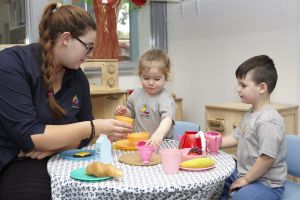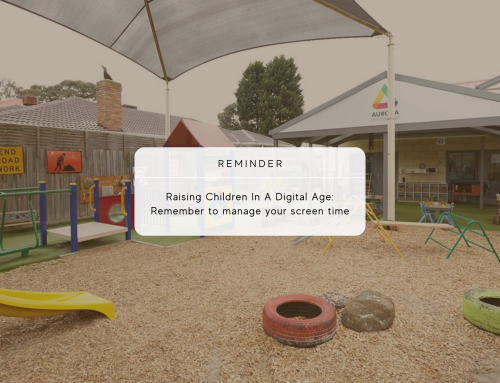Nuts have been at the center of many a spirited debate in the education industry over the past few years. To some, this may be surprising, but parents, caregivers and childcare experts know that more and more children are being diagnosed with nut allergies and suffering severely even if they ingest a trace of particular nuts. To stay on the safe side, many Australian schools maintain a no nut policy; at Aurora Early Childcare Centre, we take nut allergies seriously and are a nuts free service and ask that parents not send any food from home to reduce risks.
What Research Says
There’s a whole body of statistics and research supporting the choice to go nuts free. Allergy & Anaphylaxis Australia finds that three out of every 100 children have a peanut allergy and recommend that those with allergies have limited exposure to other tree nuts because of cross contamination.
Allergic reactions for children are particularly dangerous; mild reactions can cause facial swelling, hives and stomach upsets while severe reactions (anaphylaxis) include the swelling of the tongue, difficulty breathing, wheezing and – in extreme cases – a loss of consciousness. These reactions can be caused not just by ingesting nuts but by eating foods which contain traces of nuts.
As well as the physical health risks, anaphylaxis events can be psychologically devastating for anyone – especially young children. Research has found that children with food allergies tend to experience more fear and anxiety than children without food allergies.
A story in the Washington Post chronicles 8 year old Alexander’s psychological reaction to an anaphylactic shock; “He went from upbeat and easygoing to inflexible and controlling. He would be left off birthday-party invitation lists. He stopped playing soccer and baseball. Playdates dried up.” Parents of children who have food allergies feel similarly anxious and are constantly stressed about how to ensure that their children are not in danger in public situations.
Isn’t it our responsibility as a community and as caregivers to address and alleviate these worries? To reduce the anxiety and psychological implications that our children and families have?
Nuts Free Menus
Some people may ask: what about children who aren’t allergic to nuts? Aren’t nuts easy, healthy snacks packed with good fats? It’s true; research has found that nuts contribute to improved heart health and are a rich source of fibre. However, the nutrients which nuts provide can easily be found in other foods; sesame seeds, sunflower seeds and chia are all alternative snacks which are good sources of fibre while lentils and beans are good vegetarian sources of protein.
Even without nuts on the menu, it is easy to create healthy, balanced meals; Aurora consults with families, children and the Knox Healthy Eating Advisory Group to design delicious, nutritious menus which are completely nut free. While at Aurora, we prepare and serve all meals from morning to afternoon free, there are several resources available online for parents who need to prepare nuts-free lunches and snacks to send in with their children.
A Table Where Everyone Belongs
If institutions and families work together, we can foster an atmosphere of exclusivity and tolerance within the bounds of a nuts free service.

In educational environments which are not completely nuts free, at mealtimes children with food allergies have to be extra vigilant and sometimes even sit separately from the other children. Children who have experienced anaphylactic shock may even go so far as to become mistrustful, accusatory and withdrawn; traits which can impact their socio-emotional development. Mealtimes, which are meant to revolve around joy and bonding, become an source of anxiety and depression.
Amongst young children, accidental exposure to nuts is especially likely. Their peers and friends may not understand the depth of the issue and may – in a gesture of affection – offer them a bit of their peanut bar or nut crusted cupcake or even give them a kiss on the cheek after eating a handful of nuts. The affectionate gesture could quickly morph into an allergic reaction, alienating children with allergies, causing loneliness and a fear of separating from adults.
Do Nuts Free Environments Work?
It’s important to consider that a nuts free environment does not eliminate children’s allergies, but only minimizes risk. At present, there is no concrete evidence which shows that schools and centers with nuts free policies administer less anti-allergen medicine than other schools. In fact, a study conducted by Bartnikas et al has found that schools which designate peanut free tables have lower incidences of administrating allergy administration as compated to schools with blanket nut bans. The study concludes that further research must be conducted before we can gauge the effectiveness of nut free policies.
Additionally, eliminating nuts altogether does overlook the larger problem at hand; what is causing the increase in food allergies amongst children? Research suggest a variety of factors; one is that as hygiene and sanitation have become of a much higher priority, children are exposed to less infectious agents, therefore leading the digestive system to see certain food proteins as dangerous. Other changes may have also caused the rise; in different countries, different foods result in allergic reactions suggesting that environmental and lifestyle factors are at play. However, research is still being commissioned and there is no definitive answer about what causes the allergies.
Recently, based on a study with 640 infants, the Australasian Society of Clinical Immunology and Allergy released guidelines that recommend that parents should consciously give their children (between 4-12 months) allergenic foods such as peanut butter and eggs . According to the research, this will reduce the risk of them developing food allergies later. Speaking to The West Australian Richard Loh, an immunologist and associate professor said that reducing allergenic foods at this age will reduce allergies upto 80% in high risk babies. However, parents introducing these foods to their infants should do so in controlled circumstances with medical advice easily accessible.
Recognizing that research is still ongoing and with the present information and research on hand, we have adopted the nut free environment as the safer approach; a way we can make sure our children welcoming space to freely connect with their world and their peers and grow into secure, independent individuals.

However, we recognize that as research continues and our understanding evolves, there will always be other approaches to the problem. We’d love to hear from parents, researchers, educators and our community; what’s your take on a nuts free environment?
Have a trip to our Childcare Centre in Melbourne.
For more information and research, click on over to:
https://www.washingtonpost.com/sf/brand-connect/childrensnational/a-surprising-side-effect-of-childrens-allergies/?noredirect=on
https://www.sciencedaily.com/releases/2017/06/170629134228.htm






